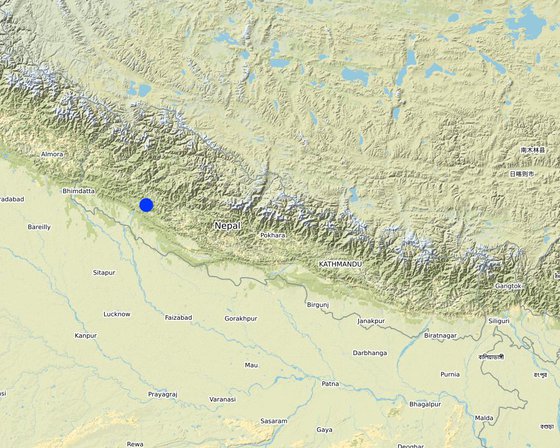



The technology is applied in a natural environment, i.e. natural water source. The source of water is a natural source of water that sits atop a small hill which is owned by the government. From the source, water is collected in RVT ( for drinking water) and concrete irrigation pond ( for irrigation). PVC pipes are fed onto the tanks to distribute the water for multiple purposes to 4 MUWS tap towers or tap systems or "Thaado". These MUWS tap towers consist of two faucets each- one for drinking and the other for irrigation and other purposes.The major purposes of this technology are to supply clean water for drinking and other multiple purposes through a cheap, effective and simple system. The natural source of water is locally maintained. Operation and maintenance works are not mandatory, however the locals are responsible for maintaining it should the need arise. The system was financed through a public-private-partnership (PPP) program; out of which some amount was funded by a Non-Governmental Organization (NGO)- Sundar Nepal ( NPR. 2,77,000 ), some amount by the Village Development Committee (VDC)- (NPR. 2,63,000), and the remaining amount was collected by a locals’ group (NPR. 60,000). For establishing the system, labor and construction materials were needed for building the tanks and pipeline systems. For the maintenance, manual labor is necessary. The quality of the water that is supplied to the households is good and the quantity seems sufficient for the 19 households. Sustainable use of water resources through a MUWS system, cheap and effective way to conserve water resources, ensuring availability of clean water even through dry seasons are some of the technology's advantages. Similarly, clean water, more water for irrigation for vegetable farming, simplifying day-to-day life are some of the strengths of the technology. Dislikes could be the limited availability of water during the dry season and that out of 4 systems only 2 are in operation and the other ones are in a non-working condition.
Management system in place for MUWS:
A separate committee is set up for the smooth operation of the system, which consists of 20 members- 10 males and 10 females. The head of the committee is Mrs. Kopila Sunar. The committee conducts a monthly meeting to discuss the problems and need of maintenance. During the initial setup, the connection of pipelines from the tap systems to the reservoir tanks was, however, done with the contribution of the locals. Every month, each family from the 19 households contributes NPR. 100 ( One Hundred Rupees) , which goes to a fund that is set up for the times of need. The labor contribution by the people of the VDC was dependent upon the number and availability of family members in the household. Similarly, the use of the MUWS system and water from it is also dependent upon the availability of family members. Little to no maintenance was done to the system till now from 2075 B.S. ( 1 years) . Equal number of male and female members are in the committee dedicated to the MUWS system.

Location: Kunathari VDC-10, Odaltaal, Province-6, Mid-Western Development Region, Nepal
No. of Technology sites analysed: single site
Spread of the Technology: applied at specific points/ concentrated on a small area
In a permanently protected area?: Nee
Date of implementation: 2018
Type of introduction






| Specify input | Unit | Quantity | Costs per Unit (NPR) | Total costs per input (NPR) | % of costs borne by land users |
| Labour | |||||
| Voluntary by locals | 100.0 | ||||
| Equipment | |||||
| Irrigation Pond | 1.0 | 275000.0 | 275000.0 | 10.0 | |
| Ferrocement Tank ( Ghaito) | 1.0 | 225000.0 | 225000.0 | 10.0 | |
| Securing fences, Perimeter securing for tanks and water source | 1.0 | 50000.0 | 50000.0 | 10.0 | |
| Setting up MUWS tap towers ( Thaado in local tongue) | 4.0 | 12500.0 | 50000.0 | 10.0 | |
| PVC Pipes | 100.0 | ||||
| Total costs for establishment of the Technology | 600'000.0 | ||||
| Total costs for establishment of the Technology in USD | 5'454.55 | ||||
| Specify input | Unit | Quantity | Costs per Unit (NPR) | Total costs per input (NPR) | % of costs borne by land users |
| Labour | |||||
| Voluntary | 100.0 | ||||
| Equipment | |||||
| Drinking water tank construction | 1 | 1.0 | 75000.0 | 75000.0 | 50.0 |
| Laying down GI pipesinstead of PVC Pipes | 1 | 1.0 | 50000.0 | 50000.0 | 25.0 |
| Total costs for maintenance of the Technology | 125'000.0 | ||||
| Total costs for maintenance of the Technology in USD | 1'136.36 | ||||
The access to health, education and markets along with other facilities is only accessible after a 15 minute journey to the ‘bazaar’ or market area from the village.
Knowledge about the technology (MUWS) improved
evaporation of water decreased after the construction of enclosures / tanks.
As per water users, effects of drought were imminent in the dry seasons, leading to less water available for drinking and irrigation. However, after the MUWS was installed, the effects of drought could be tackled; mainly due to the availability of water for drinking and drip irrigation, even during the dry and arid winter seasons.